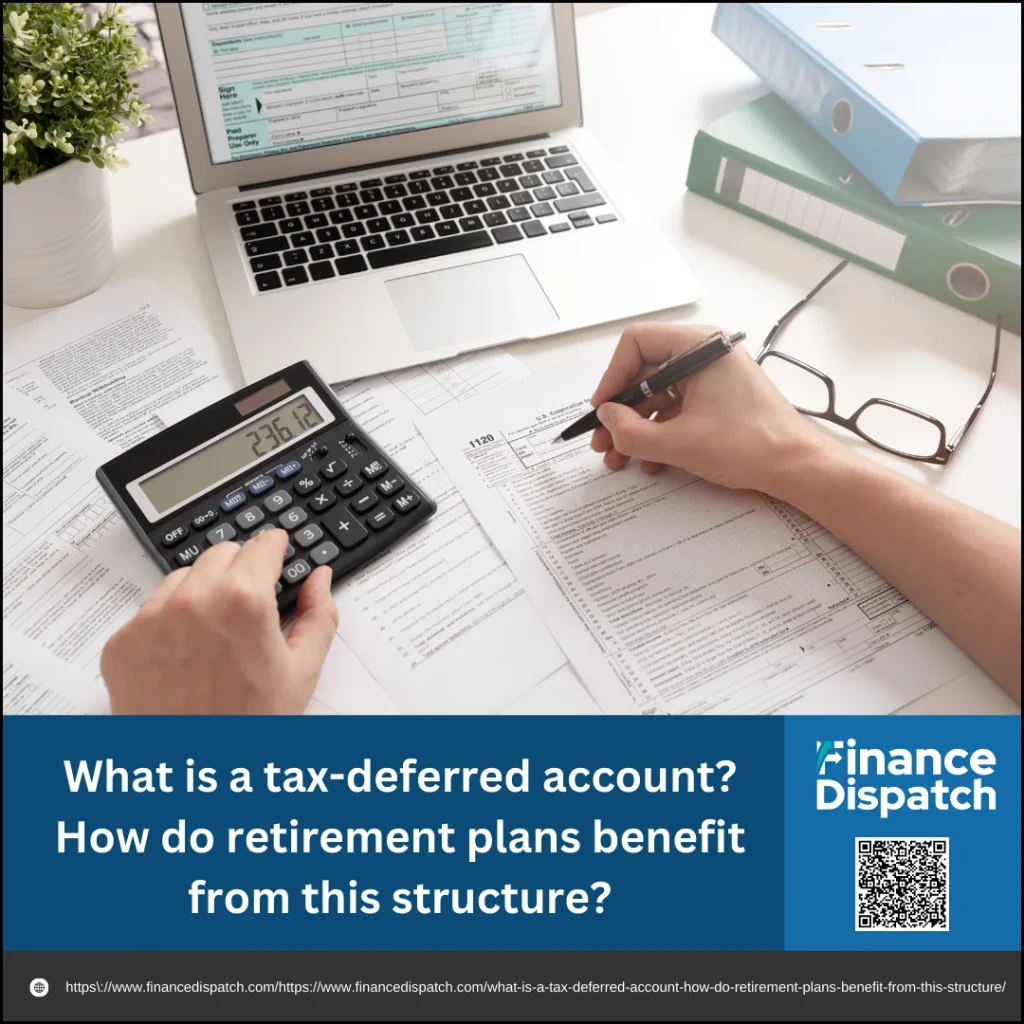When planning for your financial future, understanding how taxes impact your investments is key—and that’s where tax-deferred accounts come in. These specialized savings vehicles allow your money to grow without being taxed each year, deferring taxes until you withdraw the funds, typically during retirement. By postponing tax payments, you may take advantage of lower tax rates later in life while maximizing the power of compounding growth. In this article, we’ll explore what tax-deferred accounts are and how they serve as a vital component in building effective, long-term retirement strategies.
What Is a Tax-Deferred Account?
A tax-deferred account is a type of investment or savings account where you postpone paying taxes on the earnings—such as interest, dividends, or capital gains—until you withdraw the money, usually during retirement. These accounts are designed to encourage long-term saving by allowing your contributions and investment growth to compound without the drag of annual taxation. Common examples include traditional IRAs, 401(k) plans, and certain types of annuities. Because contributions are often made with pre-tax income, they can also reduce your taxable income in the year they’re made, providing an immediate tax benefit.
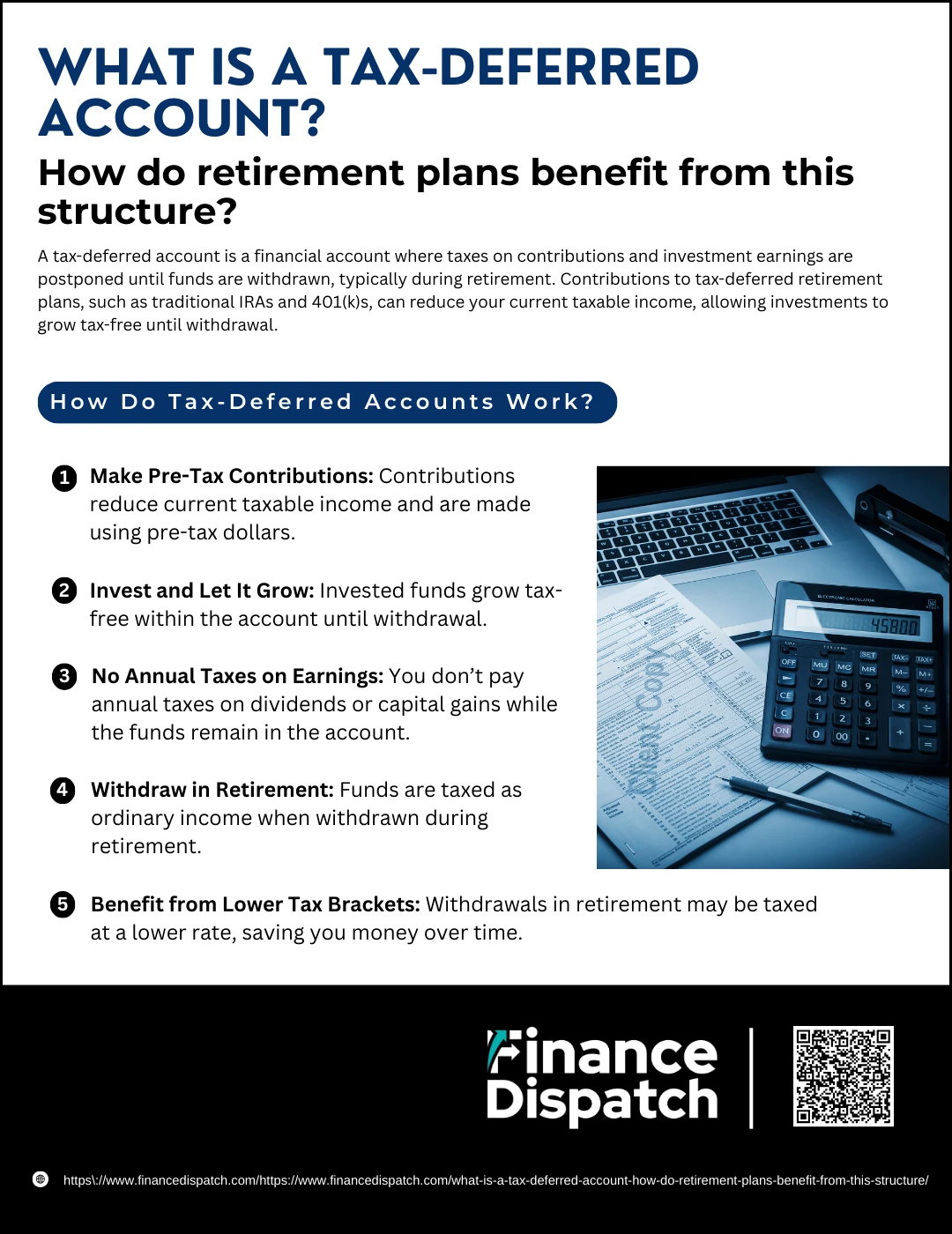 How Do Tax-Deferred Accounts Work?
How Do Tax-Deferred Accounts Work?
Tax-deferred accounts are structured to help you save more efficiently for long-term goals, especially retirement. The core benefit lies in postponing taxes on both your contributions and any earnings those contributions generate. Instead of paying taxes each year on your investment gains, you defer them until you withdraw the funds—usually when you’re older and potentially in a lower tax bracket. This not only reduces your current tax liability but also allows your entire investment to grow more rapidly through compounding. Below is a step-by-step explanation of how this process works:
1. Make Pre-Tax Contributions
You contribute to the account using pre-tax dollars (in most cases), which lowers your taxable income for that year. For example, if you earn $60,000 and contribute $6,000 to a 401(k), you may only be taxed on $54,000.
2. Invest and Let It Grow
The funds within the account can be invested in various vehicles such as stocks, mutual funds, ETFs, or bonds. Any gains—whether from interest, dividends, or capital appreciation—remain sheltered from taxes as long as they stay in the account.
3. No Annual Taxes on Earnings
Unlike taxable accounts where you might owe taxes each year on dividends or realized gains, tax-deferred accounts allow all earnings to accumulate untouched by the IRS during the accumulation phase.
4. Withdraw in Retirement
You begin taking distributions in retirement, at which point both your original contributions and the earnings are taxed as ordinary income. Since many retirees earn less than they did while working, they may be in a lower tax bracket, which means they pay less tax overall.
5. Benefit from Lower Tax Brackets
One of the biggest strategic advantages is the possibility of being taxed at a lower rate later in life. This timing shift in tax liability can result in significant lifetime savings, especially for individuals in higher tax brackets during their working years.
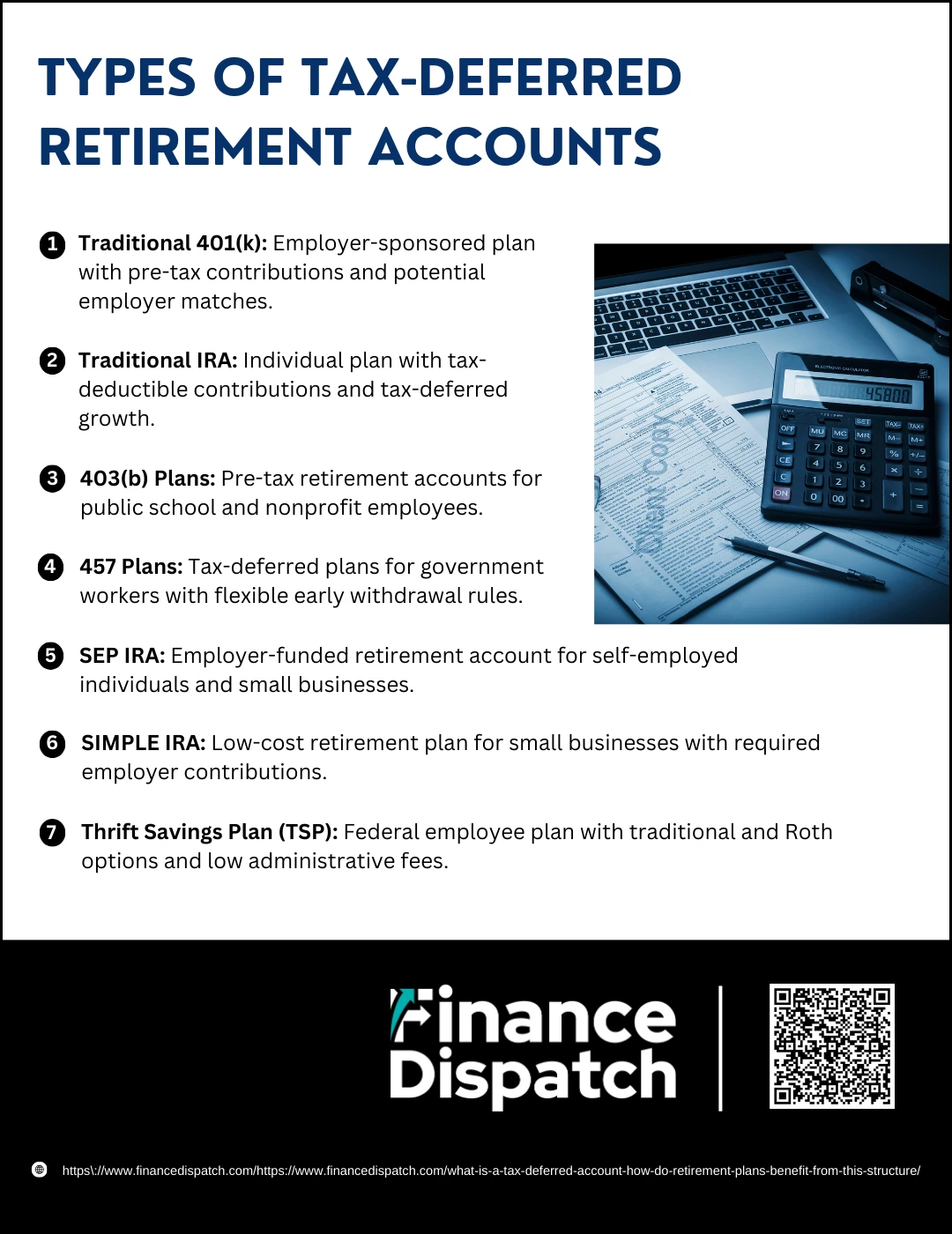 Types of Tax-Deferred Retirement Accounts
Types of Tax-Deferred Retirement Accounts
Tax-deferred retirement accounts are essential tools for long-term financial planning, enabling you to reduce current taxable income while allowing your investments to grow without the burden of yearly taxes. These accounts vary in terms of who they’re designed for—employees, self-employed individuals, small business owners, or government workers—but they all operate on the same principle: taxes are paid later, usually during retirement, when you might be in a lower tax bracket. Understanding the different types of tax-deferred accounts can help you choose the best one for your situation and maximize your savings strategy.
Here’s a more detailed look at the most common types:
1. Traditional 401(k)
This is one of the most widely used retirement plans offered by private employers. You contribute a portion of your paycheck before taxes are taken out, which reduces your taxable income. The money grows tax-deferred until withdrawal, and many employers offer matching contributions—essentially free money toward your retirement. Contribution limits for 2024 are $23,000, with an additional $7,500 catch-up allowance if you’re age 50 or older.
2. Traditional IRA (Individual Retirement Account)
A traditional IRA is open to anyone with earned income, and contributions may be tax-deductible depending on your income level and whether you have access to a workplace plan. Earnings grow tax-deferred, and taxes are paid only when you start taking withdrawals. For 2024, the contribution limit is $7,000, with a $1,000 catch-up for those 50 and older.
3. 403(b) Plans
These are similar to 401(k)s but are available to employees of public schools, nonprofits, and religious organizations. Contributions are made on a pre-tax basis, and earnings grow tax-deferred. Like 401(k)s, these accounts may offer employer matching and have the same contribution limits.
4. 457 Plans
Offered to state and local government employees and certain nonprofits, 457 plans allow pre-tax contributions with tax-deferred investment growth. One key benefit is that 457 plans don’t have early withdrawal penalties before age 59½ under certain conditions, offering more flexibility.
5. SEP IRA (Simplified Employee Pension IRA)
Designed for self-employed individuals and small business owners, SEP IRAs allow employers to contribute up to 25% of an employee’s compensation or $69,000 (for 2024), whichever is less. Only employers make contributions, and funds grow tax-deferred until retirement.
6. SIMPLE IRA (Savings Incentive Match Plan for Employees)
This is another option for small businesses with 100 or fewer employees. Employees can make salary deferral contributions, and employers are required to make either matching contributions or a fixed contribution for all eligible employees. Contributions are tax-deferred, and the plan has lower administrative costs than a 401(k).
7. Thrift Savings Plan (TSP)
Available to federal employees and members of the uniformed services, the TSP is similar to a 401(k) but offers very low administrative fees and limited investment options. It includes both traditional (pre-tax) and Roth (after-tax) options, allowing users to tailor their tax strategy.
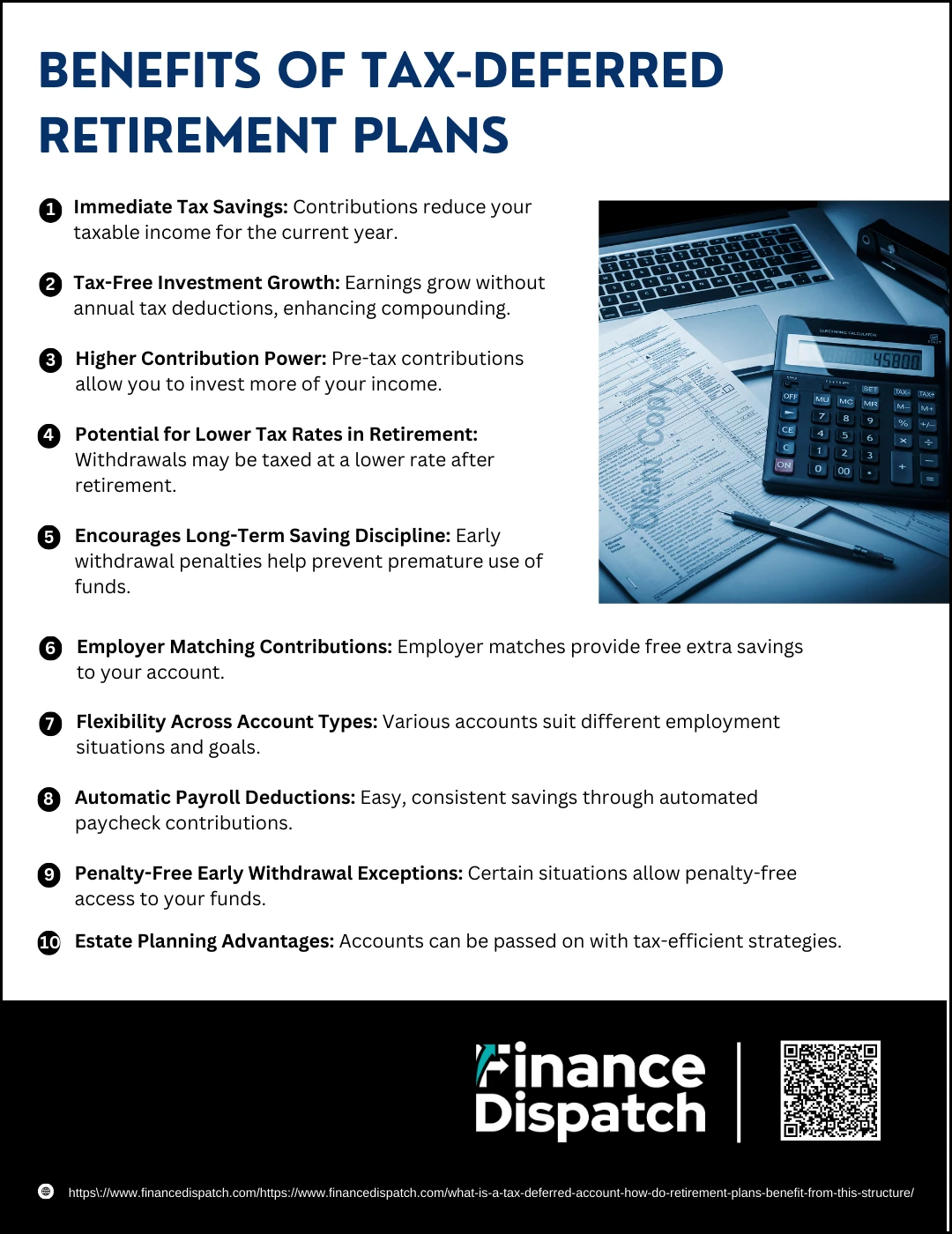 Benefits of Tax-Deferred Retirement Plans
Benefits of Tax-Deferred Retirement Plans
Tax-deferred retirement plans are more than just a tax break—they’re a strategic tool to maximize your long-term savings potential. By allowing you to delay paying taxes on both your contributions and the earnings generated from them, these plans create an environment where your investments can compound without interruption. This uninterrupted growth can significantly increase the value of your retirement portfolio over time. Moreover, tax-deferred plans are often structured with built-in incentives—such as employer contributions and automatic payroll deductions—that make consistent saving easier. These features, combined with the possibility of paying less in taxes during retirement, make tax-deferred accounts a cornerstone of smart retirement planning.
Here’s a closer look at the most compelling benefits:
1. Immediate Tax Savings
When you contribute to a tax-deferred plan like a traditional 401(k) or IRA, your taxable income for the year is reduced. This can lower your current tax bill, potentially moving you into a lower tax bracket and freeing up cash for other financial priorities.
2. Tax-Free Investment Growth
All interest, dividends, and capital gains earned inside a tax-deferred account grow without being taxed each year. This means your entire balance, including gains, continues to work for you until you start withdrawals—enhancing the power of compound growth.
3. Higher Contribution Power
Contributing pre-tax dollars allows you to invest more money upfront. For example, contributing $1,000 from pre-tax income gives you the full amount invested, whereas post-tax contributions would leave you with less than $1,000 after taxes.
4. Potential for Lower Tax Rates in Retirement
Many people earn less in retirement than during their working years. This often places them in a lower tax bracket, which means they may pay less tax on withdrawals than they would have paid on contributions during their working years.
5. Encourages Long-Term Saving Discipline
Early withdrawal penalties (typically 10% before age 59½) discourage you from dipping into your retirement funds too early. This helps protect your long-term savings and builds financial discipline.
6. Employer Matching Contributions
Many employers offer matching contributions in workplace plans such as 401(k)s. This is essentially free money that increases your retirement savings and accelerates your account growth with no additional out-of-pocket cost to you.
7. Flexibility Across Account Types
Whether you’re employed, self-employed, or a small business owner, there’s likely a tax-deferred account that suits your needs—such as 401(k)s, traditional IRAs, SEP IRAs, or SIMPLE IRAs—giving you options for how and where to save.
8. Automatic Payroll Deductions
In employer-sponsored plans, contributions are automatically deducted from your paycheck. This hands-off approach makes saving effortless and consistent, reducing the temptation to spend that money elsewhere.
9. Penalty-Free Early Withdrawal Exceptions
While early withdrawals are generally discouraged, some exceptions allow you to access your funds without penalties. Qualified expenses may include a first-time home purchase, certain medical costs, or education expenses.
10. Estate Planning Advantages
Tax-deferred accounts can be passed to beneficiaries, and while they may eventually owe taxes, strategies such as inherited IRAs or stretching distributions can help manage tax impacts and preserve wealth across generations.
Tax-Deferred vs. Tax-Free Accounts
When planning for retirement, understanding the difference between tax-deferred and tax-free accounts is crucial. Both offer unique tax advantages, but they operate differently in terms of when you pay taxes. Tax-deferred accounts allow you to delay taxes on contributions and earnings until you withdraw the funds, typically during retirement. In contrast, tax-free (or tax-exempt) accounts are funded with after-tax dollars, but qualified withdrawals—including earnings—are not taxed at all. Choosing the right mix of these accounts can help you create a more balanced and tax-efficient retirement strategy.
Here’s a comparison of tax-deferred and tax-free accounts:
| Feature | Tax-Deferred Account | Tax-Free Account (Tax-Exempt) |
| Tax on Contributions | No – contributions are often pre-tax | Yes – contributions are made after tax |
| Tax on Investment Earnings | Deferred until withdrawal | None, if withdrawn under qualified rules |
| Tax on Withdrawals | Yes – taxed as ordinary income | No – qualified withdrawals are tax-free |
| Common Examples | Traditional IRA, 401(k), 403(b), SEP IRA | Roth IRA, Roth 401(k), Health Savings Account (HSA) |
| Immediate Tax Benefit | Yes – lowers current taxable income | No – no tax deduction at contribution time |
| Required Minimum Distributions (RMDs) | Yes – starting at age 73 (typically) | No – RMDs not required (Roth IRA exception) |
| Best for | Those expecting a lower tax rate in retirement | Those expecting a higher tax rate in retirement |
| Withdrawal Penalties | 10% penalty before age 59½ (with exceptions) | 10% penalty on earnings if withdrawn early (exceptions apply) |
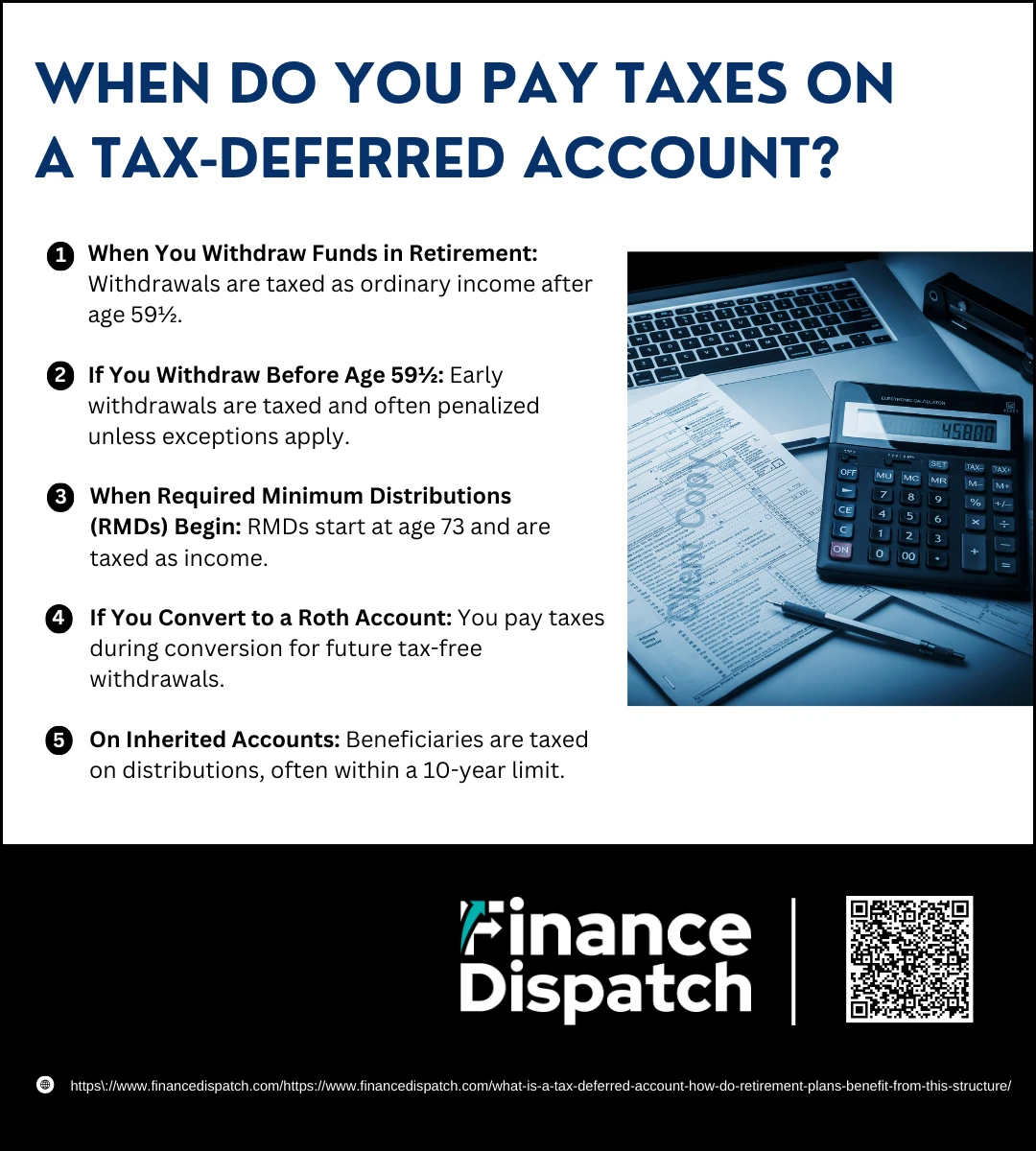 When Do You Pay Taxes on a Tax-Deferred Account?
When Do You Pay Taxes on a Tax-Deferred Account?
Tax-deferred accounts are designed to delay the tax bill, not eliminate it. While they allow your investments to grow without the drag of annual taxation, you’ll eventually have to pay taxes when you access the money. The advantage lies in the timing—you contribute with pre-tax dollars and pay taxes later, ideally during retirement when your income (and tax rate) may be lower. But the IRS has strict rules about when taxes must be paid, and understanding these rules is essential to avoid penalties and make the most of your savings.
Here’s a more detailed look at when taxes are due on tax-deferred accounts:
1. When You Withdraw Funds in Retirement
The most common time taxes are due is when you begin taking withdrawals, typically after age 59½. These withdrawals are taxed as ordinary income, including both your original contributions (if pre-tax) and any investment gains. The total amount you take out is added to your taxable income for the year.
2. If You Withdraw Before Age 59½
Early withdrawals usually come with a double cost: regular income tax and a 10% early withdrawal penalty. However, the IRS allows some exceptions—for instance, withdrawals for qualified education expenses, a first-time home purchase (up to $10,000 from an IRA), or permanent disability.
3. When Required Minimum Distributions (RMDs) Begin
Once you turn 73 (if you were born after Dec. 31, 1950), the IRS requires you to start taking annual withdrawals from traditional IRAs, 401(k)s, and similar accounts. These RMDs are taxed as ordinary income, and failing to take them can result in a hefty penalty—up to 25% of the amount you should have withdrawn.
4. If You Convert to a Roth Account
Converting a traditional IRA or 401(k) to a Roth IRA means paying taxes on the converted amount in the year of conversion. While this creates an upfront tax liability, the benefit is that future qualified withdrawals from the Roth account will be entirely tax-free.
5. On Inherited Accounts
Beneficiaries who inherit a tax-deferred account may be required to pay taxes on distributions, depending on their relationship to the original owner. Non-spouse beneficiaries generally must empty the account within 10 years of inheritance, with each withdrawal taxed as ordinary income. Spouses have more flexible options and can roll the account into their own IRA.
Common Mistakes to Avoid with Tax-Deferred Accounts
Tax-deferred accounts can be powerful tools for retirement savings, but they come with specific rules and tax implications that must be carefully managed. Missteps—such as withdrawing too early, missing required distributions, or ignoring contribution limits—can lead to unnecessary taxes and penalties. To make the most of your tax-deferred retirement strategy, it’s important to understand and avoid some of the most common pitfalls.
Here are key mistakes to watch out for:
1. Withdrawing Funds Before Age 59½: Taking money out early usually results in a 10% penalty on top of regular income tax, unless an exception applies.
2. Missing Required Minimum Distributions (RMDs): Failing to take RMDs starting at age 73 can lead to a penalty of up to 25% of the amount that should have been withdrawn.
3. Not Monitoring Contribution Limits: Exceeding annual contribution limits can trigger penalties and additional taxes. Make sure to stay within the IRS-approved limits based on your account type and age.
4. Ignoring Catch-Up Contributions After Age 50: If you’re 50 or older, you’re allowed to contribute more to tax-deferred accounts. Missing this opportunity can reduce your potential retirement savings.
5. Failing to Diversify Account Types: Relying solely on tax-deferred accounts may result in higher tax burdens in retirement. A mix of tax-deferred, tax-free, and taxable accounts can improve flexibility.
6. Not Planning for Taxes in Retirement: Assuming taxes will be lower in retirement isn’t always accurate. RMDs and Social Security income can bump you into higher brackets than expected.
7. Overlooking Roth Conversions: Ignoring the strategic opportunity to convert portions of your tax-deferred savings to Roth accounts—especially in low-income years—can lead to larger tax bills down the road.
8. Leaving Beneficiary Designations Outdated: Failing to update your beneficiaries can result in your assets going to unintended recipients or create tax issues for heirs.
9. Cashing Out Accounts When Changing Jobs: Withdrawing retirement funds when switching jobs rather than rolling them over can lead to taxes, penalties, and lost future growth.
Conclusion
Tax-deferred accounts offer valuable advantages for building retirement savings, including immediate tax benefits, long-term growth potential, and structured saving discipline. However, to fully benefit from these accounts, it’s essential to understand how they work, recognize the tax implications, and avoid common mistakes that could reduce your hard-earned savings. With careful planning—such as timing withdrawals, adhering to contribution limits, and considering a mix of account types—you can optimize your retirement income and reduce your tax burden. Ultimately, tax-deferred accounts can be a powerful part of your financial strategy when used wisely and with a long-term perspective.



